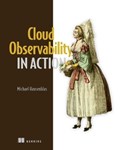Don’t fly blind. Observability gives you actionable insights into your cloud native systems—from pinpointing errors, to increasing developer productivity, to tracking compliance.
Observability is the difference between an error message and an error explanation with a recipe how to resolve the error! You know exactly which service is affected, who’s responsible for its repair, and even how it can be optimized in the future. Cloud Observability in Action teaches you how to set up an observability system that learns from a cloud application’s signals, logging, and monitoring, all using free and open source tools.
In Cloud Observability in Action you will learn how to:
A well-designed observability system provides insight into bugs and performance issues in cloud native applications. They help your development team understand the impact of code changes, measure optimizations, and track user experience. Best of all, observability can even automate your error handling so that machine users apply their own fixes—no more 3AM calls for emergency outages.
About the technology
Cloud native systems are made up of hundreds of moving parts. When something goes wrong, it’s not enough to know there is a problem—you need to know where it is, what it is, and how to fix it. This book takes you beyond traditional monitoring, explaining observability systems that turn application telemetry into actionable insights.
About the book
Cloud Observability in Action gives you the background and techniques you need to successfully introduce observability into cloud-based serverless and Kubernetes environments. In it, you’ll learn to use open standards and tools like OpenTelemetry, Prometheus, and Grafana to build your own observability system and end reliance on proprietary software. You’ll discover insights from different telemetry signals, including logs, metrics, traces, and profiles. Plus, the book’s rigorous cost-benefit analysis ensures you’re getting a real return on your observability investment.
What's inside
About the reader
For application developers, platform owners, DevOps, and SREs.
About the author
Michael Hausenblas is a Product Owner in the AWS open source observability team.
Table of Contents
1 End-to-end observability
2 Signal types
3 Sources
4 Agents and instrumentation
5 Backend destinations
6 Frontend destinations
7 Cloud operations
8 Distributed tracing
9 Developer observability
10 Service level objectives
11 Signal correlation

